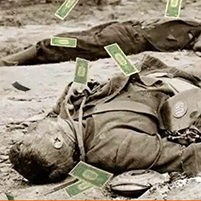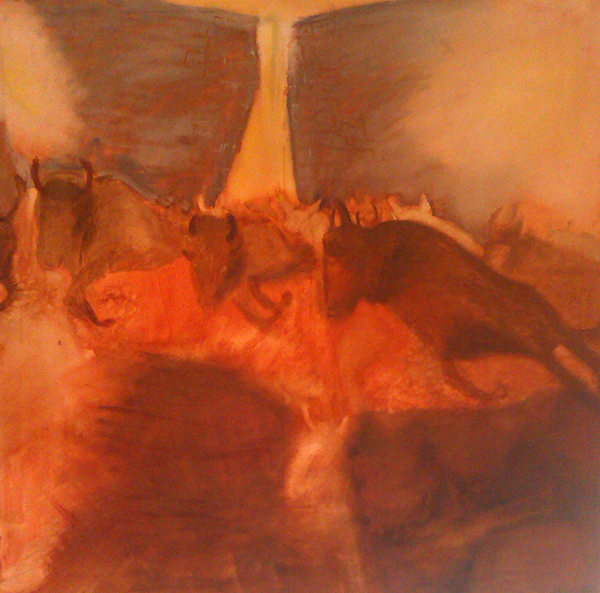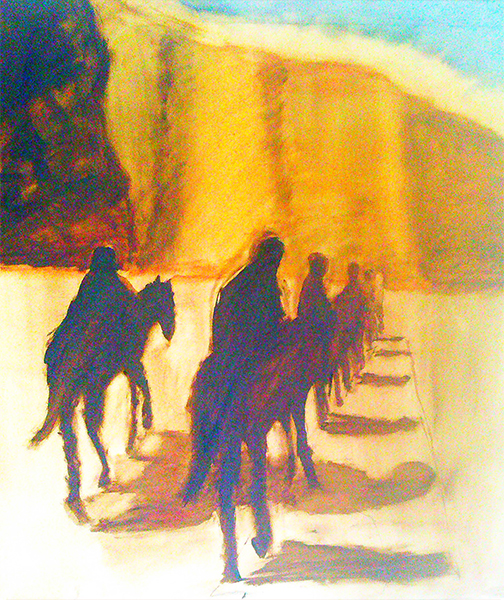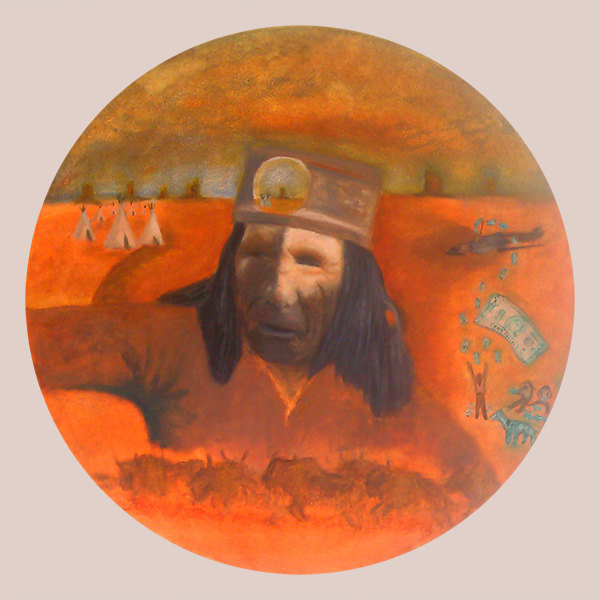Green Frog Skin Video
This is a video of montages of images interpreting the Green Frog Skin story provided by me to Mike Cheal, video maker
Spiritual Home
The buffalo (more correctly, taxonomically speaking, the American bison) was a key part of the Great Plains life of the Lakota Sioux.
The Lakota believe that all things contained spirit, not only animals, but also rocks.
It is difficult for us to understand how the Lakota could kill the buffalo in the light of this belief but they saw it as an unavoidable evil in order for them to eat and live, which had to be faced, not avoided.
The spirit of a slain animal still had to be respected, as when the animal was alive: there were ceremonies to reflect this in Lakota lore.
The Lakota chased buffalo ruthlessly, including over ravines (‘pis’kuns’) to kill them more easily. My painting is in part a representation of that. I did not intend to sanitize the Native American ways. However, the US not only killed the buffalo on an industrial scale, due to rifle, railroad, and profit from the mechanisation of tanning methods, but also as sport (as recorded by Custer himself) and ultimately as part of a policy to weaken and destroy a key support of the Native American way of life.
The Spiritual Home also represents the place where the buffalo spirit lived on after death, and also reflects the buffalo’s place in the landscape.
Returning Home
One of Edward Curtis’s famous Native American photos shows a line of Navaho Indians on horses fading off into the distance. It was entitled, brilliantly, ‘Vanishing Race’
Not only were the individual riders moving towards the vanishing point in the photo but that their whole way of life was vanishing too. Their ‘home’, like that of most Native Americans, had been displaced, to a small reservation, detached from the broad natural canvas of their world.
Seeker of Visions
This is my central portrait of Native American thinker Lame Deer (1901/3 -1976) and a representation of the key symbols he mentions in ‘Seeker of Visions’, the book of his thinking as told to his friend Richard Erdoes.
A key symbol is the Native American circle image versus the US square image (think of buildings, boxes, gadgets, our ‘boxed in’ lives, ruled by time etc)
So, my painting had to be on a circular canvas!
Other symbols in the painting are:
Bottom: the buffalo, which are painted very thinly. I was pleased with the ‘cave painting’ effect. The buffalo is a symbol of a way of life and a natural landscape, now lost.
Top left: circles of tipis. Circles within circles here. The tipi literally means shelter and it is a circle itself, a gathering.
On the horizon: the ‘mesa’ and ‘butte’ geological formations of the Badlands landscape of South Dakota. The Badlands were a Sioux hunting ground, for buffalo and other animals
In the sky: the bald headed eagle. A symbol of many natural things in the Native American world. A symbol of money and power on the US dollar and seal.
On the right : a symbolic story….
In 1876, the Lakota lead by Crazy Horse won a rare victory over the US at the Battle of Little Big Horn when Custer’s 7th Cavalry were defeated. The next day, the Indians saw what they described as ‘green frog skins’ drifting up from the uniform pockets of some of the dead US soldier on the battlefield. The Indian children folded these ‘green frog skins’ into little toy horses. The ‘green frog skins’ were the dollar bills by which the US paid the wages of the soldiers.
Lame Deer Study
After I had finished ‘Seeker of Visions’, my artist friend Ed Cooper suggested that I try a study from another image on the net of Lame Deer, a one which had single directional right. This is the result.
I think it captures a face of proud resignation.
Moon Creek
Water is one of four natural, spiritual elements to the Lakota Sioux that they use in many of their rituals, the other three being fire, rock and green (i.e. trees/vegetation). This painting also depicts the Moon. The cosmos is the natural and spiritual world beyond ‘Grandmother Earth’.
I loosely based the work on a photograph by the pre-eminent photographer of the fading traditional Native American lifestyle, Edward Curtis (1868 -1952).
As I was painting it, it seemed natural to place the arm of the Indian boatman in the water to show the unity of all things in a dramatic pictorial way.







